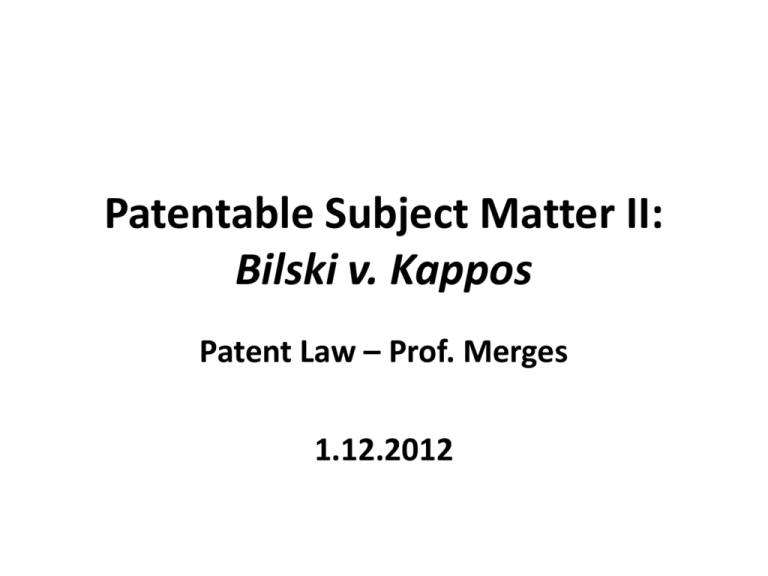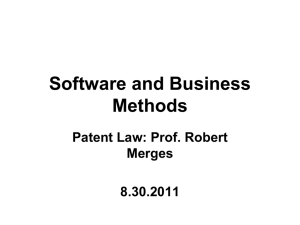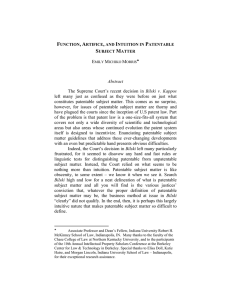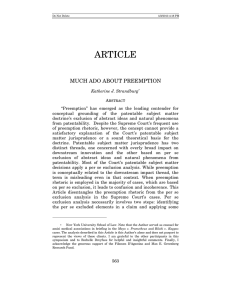Patentable Subject Matter II: Bilski v. Kappos
advertisement

Patentable Subject Matter II: Bilski v. Kappos Patent Law – Prof. Merges 1.12.2012 “purified and isolated” genes 1.An isolated DNA coding for a BRCA1 polypeptide, said polypeptide having the amino acid sequence set forth in SEQ ID NO: 1. 2. The isolated DNA of claim 1, wherein said DNA has the nucleotide sequence set forth in SEQ ID NO:2. Sequence ID’s • Long strings of abbreviations for amino acids (e.g., Phe-Leu-Ser-Cys . . .) • Long strings of base pairs for DNA sequences such as genes (TAGCTGGCATAT . . . .) United States Court of Appeals for the Federal Circuit 2007-1130 545 F.3d 943 (Fed. Cir. 2008) IN RE BERNARD L. BILSKI and RAND A. WARSAW Main points • Rejection of claims to commodity price hedging technique – AFFIRMED • Announces a new/old “machine or transformation” test for patentable subject matter What is the claim in Bilski about? • Fixed price contract: creates a risk that prices will fall; protects against the risk that prices will rise • What if you wanted to reduce the risk without losing the protection? Hedging • Simple examples: travel insurance; spending money on a “backup plan” • More formally: Hedging risk from a major purchase by making an offsetting investment WeatherWise USA, located in Pittsburgh, PA, is the premier provider of customized consumer energy products including SetYourBillSM, WeatherProof Bill®: fixed bills, capped bills, EnerCheck® energy efficiency . . . Our unique use of computerized models based on engineering, rather than econometric principles enables the development of products and services that reduce financial risk for energy providers and their residential and commercial consumers. Can you patent something like this? • The section 101 question • NOTE: Distinct from other requirements of patentability – NOT asking whether claim 1 in Bilski is new, nonobvious, etc. A method for managing the consumption risk costs of a commodity sold by a commodity provider at a fixed price comprising the steps of: (a) initiating a series of transactions between said commodity provider and consumers of said commodity wherein said consumers purchase said commodity at a fixed rate based upon historical averages, said fixed rate corresponding to a risk position of said consumer; Bilski claim 1 cont’d (b) identifying market participants for said commodity having a counter-risk position to said consumers; and (c) initiating a series of transactions between said commodity provider and said market participants at a second fixed rate such that said series of market participant transactions balances the risk position of said series of consumer transactions. Narrower, “dependent” claim 2. The method of claim 1 wherein said commodity is energy and said market participants are transmission distributors. Rejection: The process involved abstract intangible entities: transactions, legal relationship, market participants having a “counter-risk position,” and more “transactions” to balance risk positions. • The process was of the type that could readily be carried out by a human being – without using any kind of machine. Nothing physical (not even data) appeared to be transformed by the claimed process Contrast: chemical process Federal Circuit in Bilski • Stated the “Machine or Transformation” test • In order to be a patentable process, a process must either: –Transform an article to a different state or thing, and/or –Be “tied to a particular machine.” Reliance on Supreme Court Cases Gottschalk v. Benson, 409 U.S. 63 (1972). Parker v. Flook, 437 U.S. 584 (1978). Diamond v. Diehr, 450 U.S. 175 (1981). • Gottschalk v. Benson (1972) involved the conversion of binary-coded decimal (BCD) data to a pure binary format, found merely an effort to patent an algorithm. • No machine; involved transformation of unspecified data. • Diamond v. Diehr (1981) involved a computercontrolled process of making tires, definitely a physical transformation that was also tied to a machine. • These cases are, for now, the primary guides for determining patentable subject matter. “When a claim containing a mathematical formula implements or applies the formula in a structure or process which, when considered as a whole, is performing a function which the patent laws were designed to protect (e.g., transforming or reducing an article to a different state or thing), then the claim satisfies 101's requirements.” -Gottschalk v. Benson, 409 U.S. 63 (1972). Bilski v Kapppos 130 S Ct 3218 (2010) Bilski v. Kappos • Holding • “Roads not taken” • History, context – and future? Supreme Court approach: The Big 7 • Four categories of patentable subject matter – Process, machine, manufacture, composition of matter – Then the 3 exceptions Process definition “process, art or method, and includes a new use of a known process, machine, manufacture, composition of matter, or material” – 35 USC 100(b) The Court's precedents provide three specific exceptions to § 101's broad patent-eligibility principles: “laws of nature, physical phenomena, and abstract ideas.” Chakrabarty, supra, at 309. While these exceptions are not required by the statutory text, they are consistent with the notion that a patentable process must be “new and useful.” And, in any case, these exceptions have defined the reach of the statute as a matter of statutory stare decisis going back 150 years. The Holding Rather than adopting categorical rules that might have wide-ranging and unforeseen impacts, the Court resolves this case narrowly on the basis of this Court's decisions in Benson, Flook, and Diehr, which show that petitioners' claims are not patentable processes because they are attempts to patent abstract ideas. Indeed, all members of the Court agree that the patent application at issue here falls outside of § 101 because it claims an abstract idea. Two “Roads Not Taken” 1.Federal Circuit “machine or transformation” test 2.“Categorical prohibition” on business methods Under the Court of Appeals' formulation, an invention is a “process” only if: “(1) it is tied to a particular machine or apparatus, or (2) it transforms a particular article into a different state or thing.” 545 F.3d, at 954. This Court has “more than once cautioned that courts ‘should not read into the patent laws limitations and conditions which the legislature has not expressed.’ ” Diamond v. Diehr . . . . Ordinary meaning: Adopting the machine-ortransformation test as the sole test for what constitutes a “process” (as opposed to just an important and useful clue) violates [several] statutory interpretation principles. Categorical exclusion • Again, plain meaning; dictionary definition of “process” does not exclude business methods/processes • Section 273(b)(1) of the Patent Act – prior user defense for business methods Supp. at 9 [I]f a patent-holder claims infringement based on ‘‘a method in [a] patent,’’ the alleged infringer can assert a defense of prior use. For purposes of this defense alone, ‘‘method’’ is defined as ‘‘a method of doing or conducting business.’’ §273(a)(3). Holding (cont’d) The concept of hedging, described in claim 1 and reduced to a mathematical formula in claim 4, is an unpatentable abstract idea, just like the algorithms at issue in Benson and Flook. Allowing petitioners to patent risk hedging would pre-empt use of this approach in all fields, and would effectively grant a monopoly over an abstract idea. One rejected view Respondent urges the Court to look to the other patentable categories in § 101-machines, manufactures, and compositions of matter-to confine the meaning of “process” to a machine or transformation, under the doctrine of noscitur a sociis. Under this canon, “an ambiguous term may be given more precise content by the neighboring words with which it is associated. [But] § 100(b) already explicitly defines the term “process.” What lies behind this rejected view? • “Patents are about technology” – machines, manufactures, compositions of matter . . . • “Technological arts” concept in Europe and some earlier US cases: rejected The plurality portions of the majority opinion – Justice Kennedy The machine-or-transformation test may well provide a sufficient basis for evaluating processes similar to those in the Industrial Agefor example, inventions grounded in a physical or other tangible form. But there are reasons to doubt whether the test should be the sole criterion for determining the patentability of inventions in the Information Age. Dissent: Justice Stevens The wiser course would have been to hold that petitioners' method is not a “process” because it describes only a general method of engaging in business transactions-and business methods are not patentable. More precisely, although a process is not patent-ineligible simply because it is useful for conducting business, a claim that merely describes a method of doing business does not qualify as a “process” under § 101. Dissent (cont’d) “[p]erhaps this was in part a function of an understanding – shared widely among legislators, courts, patent office officials, and inventors – about what patents were meant to protect. Everyone knew that manufactures and machines were at the core of the patent system.” Merges, Property Rights for Business Concepts and Patent System Reform, 14 Berkeley Tech. L.J. 577, 585 (1999) (hereinafter Merges) “Patent originalism” • In keeping with recent trends in Supreme Court jurisprudence and scholarly discourse • But very difficult to apply to a field where innovation is the cornerstone of the entire enterprise Originalism and the Constitution • Eg, District of Columbia v. Heller, 128 S.Ct. 2783 (2008), the recent Supreme Court case on the 2nd Amendment Bilski and patent volume • It is difficult to separate the conceptual question in cases such as Bilski – what types of creative ideas/products should be allowed to be patented? – from certain practical issues • Particularly, the “floodgates” problem The USPTO issued more utility patents in calendar year 2011 than in any year in history. The 2011 total – just shy of 225,000 issued patents – is only a small increase over 2010, but towers above all other historic figures. The previous record was set in 2006 with about 173,000 issued utility patents. – PatentlyO.com 1/5/12 “Patent Failure”, Bessen and Meurer AS MANY AS SIX IMPOSSIBLE PATENTS BEFORE BREAKFAST: PROPERTY RIGHTS FOR BUSINESS CONCEPTS AND PATENT SYSTEM REFORM, 14 BTLJ 577 (1999) By Robert P. Merges • Merges, Software and Patent Scope: A Report from the Middle Innings, 85 Tex. L. Rev. 1528 (2007)



![Introduction [max 1 pg]](http://s3.studylib.net/store/data/007168054_1-d63441680c3a2b0b41ae7f89ed2aefb8-300x300.png)


